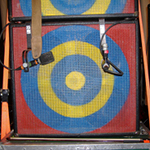Kate Gilmore
Kate Gilmore
Smith-Stewart
53 Stanton Street, New York, NY
November 21, 2008–January 18, 2009
Although Kate Gilmore describes herself as a sculptor—she often builds and maneuvers through constructions of lumber, plaster, wooden chairs, and plastic buckets in her work—her true medium is video, and like a true material girl, she’s the star in every one. In her third solo show in New York and her debut at this gallery, Gilmore further develops ideas about women and empowerment, but a tempestuous aggression replaces the heartfelt vulnerability of her earlier work.
Captured with a stationary camera in a single take, the four videos in this show portray Gilmore as an urban everywoman: chicly dressed but clearly uncomfortable in her hastily built interiors. Walk This Way (all works 2008) depicts the artist, dressed in fancy black heels, dark tights, and a gray dress, kicking and punching with unassailable determination through two Sheetrock walls. The video unfolds on a monitor at the end of a short, narrow, Nauman-like corridor in the front of the gallery; it is here that the artist was filmed breaking through the parallel walls.
Gilmore trades in her heels for sledgehammers in High Horse and Down the House. In the latter, she is seen from above in a fluorescent-lemonade dress, standing atop a rickety heap of plaster blocks and wood pieces, all splattered with red and hot-pink paint, as she attacks this foundation with all her might. Like Courbet’s The Stonebreakers, 1849, Gilmore’s labors—though fascinating to watch and even more mesmeric to hear through a cacophonous din from all four works playing simultaneously—seem to provide no clear redemption or resolution. The melancholy continues at the conclusion of Between a Hard Place, where after smashing and climbing through five more sheets of drywall, Gilmore turns to face the camera and, taking off her party gloves, reveals an exasperating pathos that simultaneously exclaims “I did it!” and asks “Was it worth it?”
Originally published at Artforum.com on December 15, 2008.
